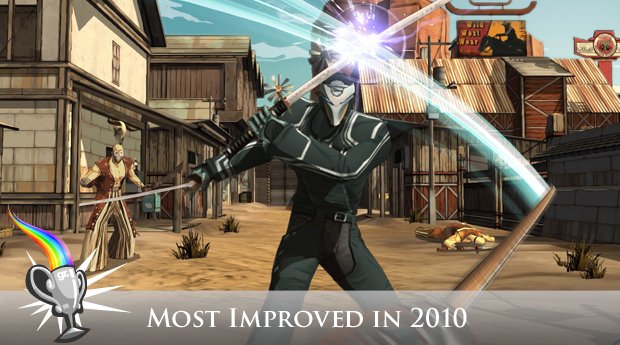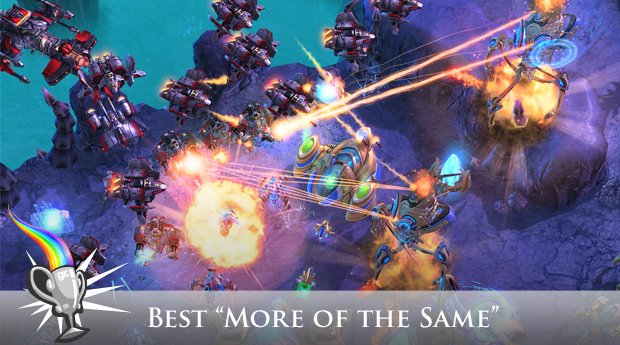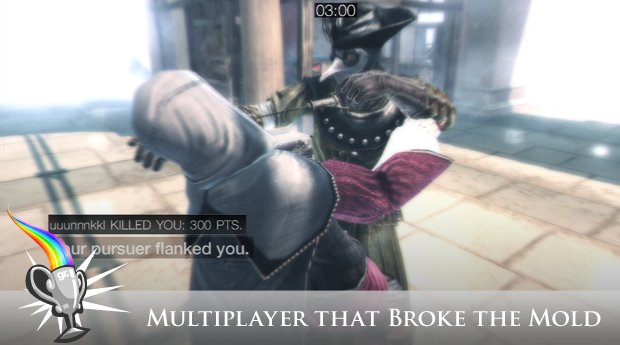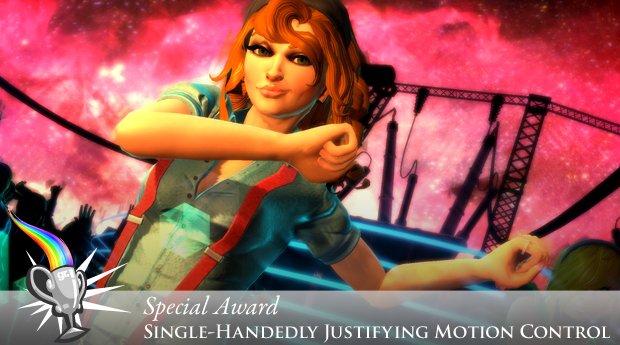The Platinum Chalice Awards 2010
The best games of 2010, honored with the glittering trophies and glowing tributes they truly deserve
WINNER: BioShock 2
"We thought BioShock 2 was a mistake." That's the very first line of our review, and we weren't kidding around. The original game was so revered in the GamesRadar offices that the announcement of a sequel – less than a year later, and without the direct involvement of lead designer Ken Levine – worried all of us, bothered some of us and straight up angered at least one of us.
But, as we admit a little later in the review, we were wrong. BioShock 2 is just as good as its predecessor overall and, in some significant ways, better. The guns are more satisfying, the plasmid combination is more creative, the characters are more sympathetic, the enemies are more sinister… Andrew Ryan never threw anything as terrifying as a Big Sister your way. And while the origin of the hero may not prove as mind-blowing a mystery, it does prove more motivating.
Don't take the title of this award as a backhanded compliment, then. Instead, consider us pleasantly – and gratefully – surprised.
Lara Croft and the Guardian of Light

Most agreed that Lara Croft's formula could use some tweaking, but a twin-stick shooter? Quite the bizarre shift, and yet it worked surprisingly well, providing spectacular shootouts and platforming, as well as a clever co-op based puzzle system. Trust us on the latter – Guardian of Light was 2010's best method for convincing your non-gamer boyfriend or girlfriend to pick up a controller and play along.

WINNER: Red Steel 2
Just yesterday we sang the praises of Red Steel 2, but for the sake of really getting our point across, we’ll say it again – this is the best FPS on Wii, period. In a rare surprise, the Wii MotionPlus sword controls really make you feel like a badass samurai, able to slash, slice, crush and sneak-stab any number of enemies in just a few seconds. Your abilities start off rather meager, then escalate as the story progresses. By then end, you’re practically engaging in first-person, Devil May Cry-style fisticuffs with roomfuls of baddies.
On top of the controls are the visuals, which, in another welcome surprise, look mighty fine even in 480p. Ubi dropped the drab style of the first game (along with everything else) and replaced it with a Borderlands-esque sci-fi Western feel, including a strong soundtrack that would be right at home in new episodes of Firefly. We know you probably won’t, but… you really should check this out with an open mind and see what happens.
Just Cause 2

Better physics, more stuff to hijack, faster action and lots of opportunities to creatively ruin things make the difference in this amazing sequel. There are beautiful vistas for your eyes at every turn in the game from daunting snow-topped mountains right down to the sun-kissed beaches. Throw in a new tether system to snag pursuing vehicles to each other and you’ve got yourself one hell of a stunning world to play in.
Weekly digests, tales from the communities you love, and more

WINNER: StarCraft II
StarCraft II didn't even attempt to offer players a new or unique RTS experience. That's because it didn't have to… after 12 years, the original was still the unsurpassed and definitive benchmark of the real-time strategy genre, regardless of whether you were drawn to the campaign or to the competition.
Which is why we love this sequel. Blizzard didn't bother reinventing the wheel – the company wisely chose to repaint, polish and perfect the wheel instead, adding better graphics, better units, balanced races, the slick new Battle.net and more actions-per-minute than a South Korean pro clicker to what is basically the same gameplay formula. In other words, you can micro-manage your economy and army just like you've done for the past decade, but now you don't have to feel like an obsolete old geezer for doing so.

Rock Band 3
The truth? We’re sick of rhythm action games. So why care about Rock Band 3? Because it doesn’t just preserve the genre’s original magic. It enables us to make our own magic, teaching us the real guitar, drum, and keyboard parts. Simulation? Not anymore. This is reality. And it rocks.

WINNER: Assassin's Creed: Brotherhood
Even those of you who don’t care about multiplayer will want to take notice of this one. Assassin’s Creed: Brotherhood’s multiplayer is based around a simple concept, but one that hasn’t ever really been explored in videogames (except for maybe in the 2007 PC title The Ship): every player, working alone, has to track down another player randomly selected as his or her target. At the same time, everyone’s being hunted by at least one other person. But what makes it especially interesting is that multiplayer matches unfold in crowded environments, filled with NPCs that look exactly like you and all of your opponents.
Success comes from being able to find your targets without your pursuers finding you, which means you’ll have to do your best to blend in. That means no running, no attacking and definitely no running around on rooftops – unless, of course, you think you can get away with it. That tension, combined with the thrill of getting the drop on other players who think they’re staying hidden, makes Brotherhood’s multiplayer this year’s most unique online experience – as well as its most uniquely satisfying.
Need for Speed: Hot Pursuit

Online racing has always been a mess of quitters, dicks and noobs, so Need for Speed: Hot Pursuit deserves the multiplayer equivalent of a Nobel Peace Prize for making sense of it all. Beating friend-specific records via the Autolog is ridiculously addictive, yet the multiple victories made possible by the titular Cops vs. Crooks mode is the reason you’ll find more of us racing online over any FPS this season.

WINNER: Darksiders
Darksiders' biggest influence isn't clear right away. At first, one might think it's a God of War clone, what with the combo-based combat, and the angry protagonist up against celestial forces. Later on, though, the main inspiration becomes glaringly obvious, and yet it's utterly unexpected for such a grim apocalypse tale: Darksiders borrows its entire quest structure, special items and puzzle-boss approach from Zelda! There's the hook shot, the boomerang, a horse you can call to your side, dungeons with chests that provide maps and even "heart containers" – you almost expect the notes "duh-duh-duh-DUH" to play when you find a new item.
And yet the game is still so much fun, so compelling with its imaginative world and visceral combat that no one cared it was a blatant rip-off. Creative Director Joe Madureira's comic book chops shined through in every chunky character design, every slightly cartoony crumbled building or demonic spire jutting into the sky and we can’t wait to see where the series will go next.
Castlevania: Lords of Shadow

If ever the word "pastiche" could apply to a game, Lords of Shadow is it. Smash together God of War, Shadow of the Colossus, perhaps some Tomb Raider/Uncharted and bits from a hundred other games and you get… Castlevania? It’s a baffling soup of influences, but damn if it doesn’t come together beautifully… in no small part due to a magic system that actually is original. The voice of Patrick Stewart certainly doesn't hurt either.

WINNER: Dance Central
Motion controls. Over the years these two words have brought on more teeth-gnashing than praise from gamers. Gamers don't want to waggle a remote to simulate bowling or wave a controller to slash through an enemy.
So when Microsoft announced that it too was jumping into the motion control fray the collective eye roll of gamers worldwide almost shifted the earth's axis. Exclaiming "You are the controller!" Kinect took a look at Sony and Nintendo, stuck its tongue out and then proceeded to hype up the same damn trivial sports/pets/minigames titles.
Then came Dance Central. Harmonix created a game that utilized motion control to its full extent in a game where it made the most sense. Dancing, regardless of how well you can do it, requires that you get up and move. The technology behind Kinect was tailor made for a game where mimicking choreographed moves can be accurately tracked to see how well you're tearing up the dance floor of your living room. And, while it can be argued that the motion control technology behind the Kinect is the best out of the three, Dance Central is the game that made flailing around in front of your TV fun.


